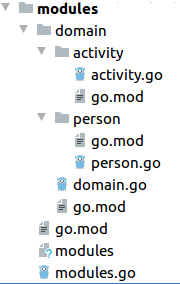Go version: 1.12.9
Here is the structure of a simple demo project:
So we have a module domain, which contains two modules: activity and person.
I would like to use domain with all nested modules in the main file => modules.go.
I know how to import domain in the main go.mod:
module modules
go 1.12
replace modules/domain v0.0.0 => ./domain
require modules/domain v0.0.0
So after that can use code from domain/domain.go, but I cannot access code from activity and person modules.
Yes, I could manually import nested modules, for example:
(main go.mod):
module modules
go 1.12
replace modules/domain v0.0.0 => ./domain
replace modules/domain/activity v0.0.0 => ./domain/activity
require (
modules/domain v0.0.0
modules/domain/activity v0.0.0
)
but I don't want to manually import all submodules.
How to configure modules to import domain with all submodules?



